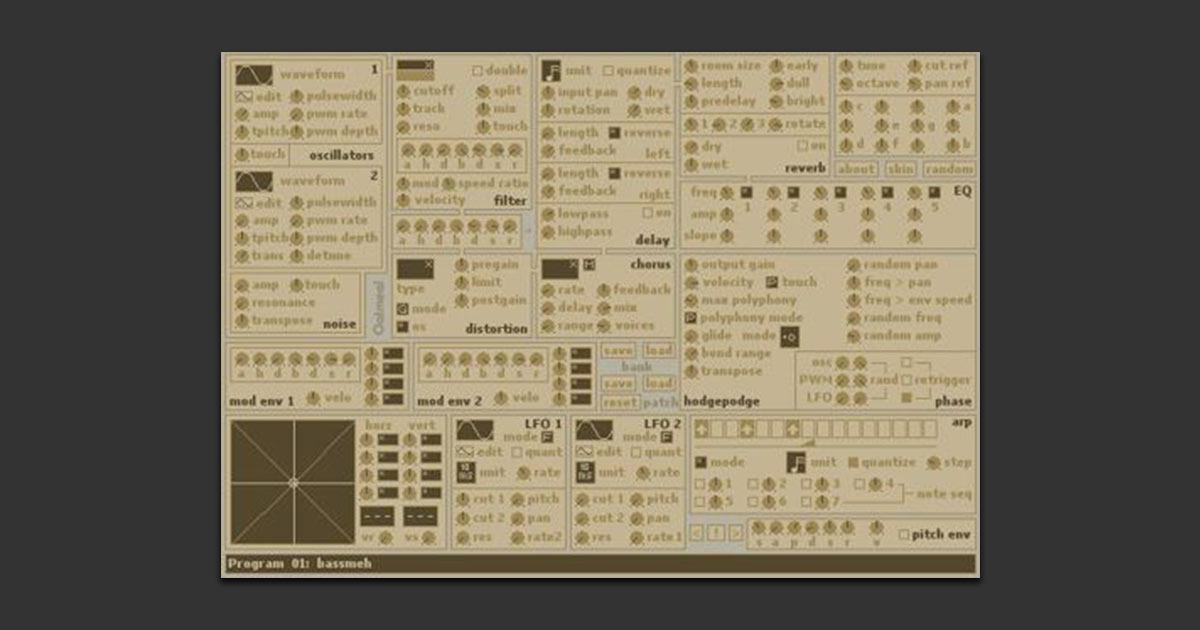
Fuzzpilz Oatmeal VSTi
Oatmeal is a free two-oscillator subtractive synth VST plugin...
Oatmeal is a two-oscillator subtractive synth.
Features
Two oscillators:
- Waveform: sine, sawtooth, pulse (square), triangle, user, and “user PWM”.
- Amp: Amplitude of the oscillator.
- Tpitch (aftertouch > pitch): The effect of note velocity and later pressure changes on the oscillator’s pitch.
- Pulsewidth, PWM rate, PWM depth. These are ignored unless the waveform is “pulse” or “user PWM”, in which case they set the base pulsewidth and the modulation rate and depth.
- Trans (transpose): Transposition of the second oscillator relative to the first (i.e. the voice’s pitch).
- Detune: Constant frequency shift of the second oscillator.
- Touch (aftertouch > osc amp): The effect of note velocity and pressure changes on both oscillators’ amplitude.
Noise (white or bandpassed):
- Amp: Noise amplitude.
- Touch: The effect of note velocity and pressure changes on the noise level.
- Resonance: If this is 0, unfiltered white noise is generated. Higher values increase the resonance of the bandpass filter, making the output purer.
- Transpose: Transposition of the filter’s center frequency relative to the note.
Filter:
- Filter type.
- Double (filter doubling): If this is enabled, two copies of the filter are run in parallel. See the “split”, “mix”, and “speed ratio” parameters.
- Cutoff: Cutoff or center frequency of the filter.
- Track (keytracking): In octaves/octave: if it is 1, an increase in the voice’s pitch of one octave will cause the cutoff to increase by the same amount.
- Reso (resonance): Resonance of the filter (if applicable).
- Split: If doubling is on, the second filter’s cutoff frequency will be this much higher than the first’s.
- Mix: If doubling is on, this changes the output amplitude ratio between the two filters.
- Touch (aftertouch > cutoff): The effect of note velocity and pressure changes on both filters’ cutoff frequencies.
- Mod (envelope modulation): Strength and direction of the filter envelope’s effect.
- Velocity: Effect of note velocity on the envelope modulation depth, not on the filter cutoff itself.
- Filter envelope: For details, see the envelope block below.
- Speed ratio: If doubling is on, the second filter’s envelope will move at this rate relative to the first’s.
Envelope:
- Attack: The time it takes for the level to reach 1.
- Hold: After reaching 1, the level stays there for this long.
- Decay 1: The time it takes for the level to reach the breakpoint; however, if the breakpoint is set to 1 (0 dB), this is skipped.
- Breakpoint: The point reached after the first decay phase (see just above to see what happens if you set this to 0 dB); immediately followed by
- Decay 2: The time taken for the level to change from the breakpoint to the sustain level.
- Sustain: Sustain level.
- Release: Release time.
Distortion:
- Type: Hard clip, soft clip (tanh), sine (which can produce fm-like timbres or, failing that, horrible noise), or asymmetric.
- Mode: This sets where the distortion is applied:
Global: i.e. once, after summing all the voices.
Per voice: after the filter.
Per voice: before the filter.
Double: i.e. per voice before the filter and then again after summing the voices. - Oversample: Oversamples the distortion to reduce aliasing.
- Pregain.
- Limit: The level at which the signal is clipped (or the amplitude of the sine).
- Postgain: In double mode, this is not applied to the per-voice distortion.
Chorus:
- Mode: Sine, Ramp, and FM are essentially the same thing with different LFO shapes. Irregular is a bit different: the delay times of the voices vary randomly within the given range.
